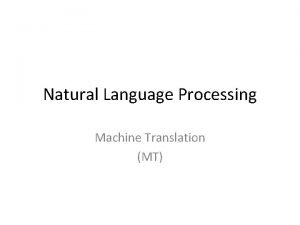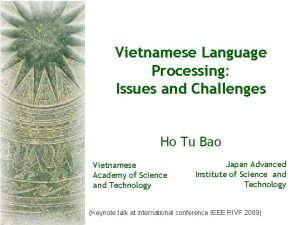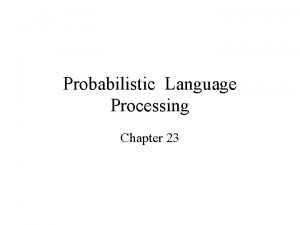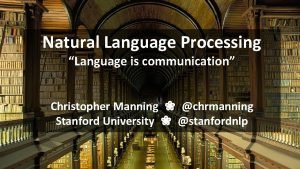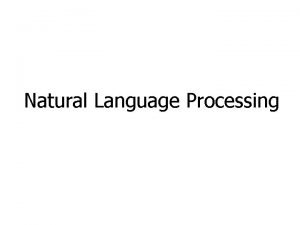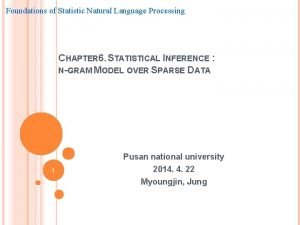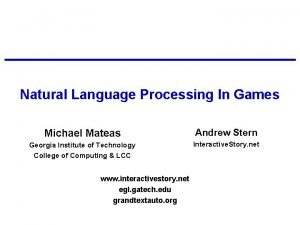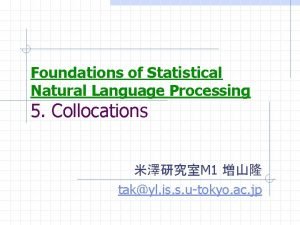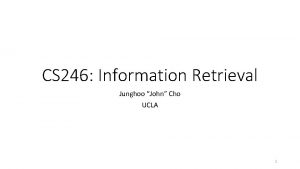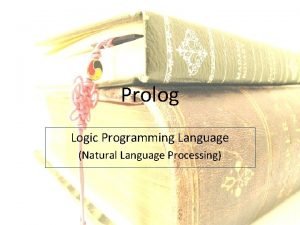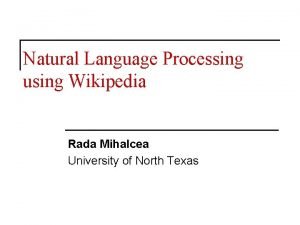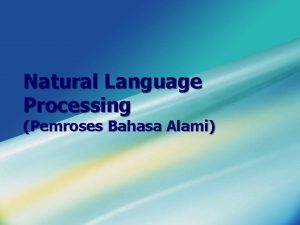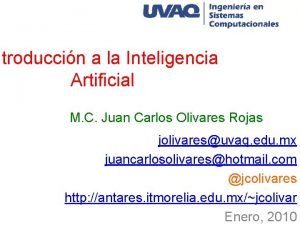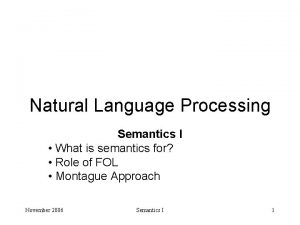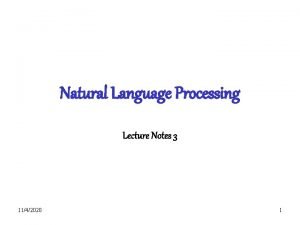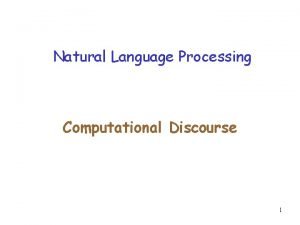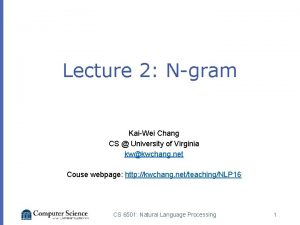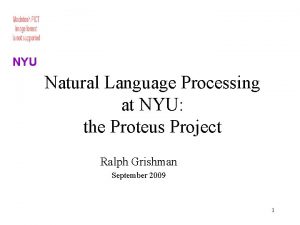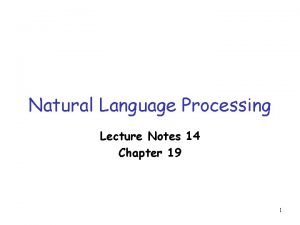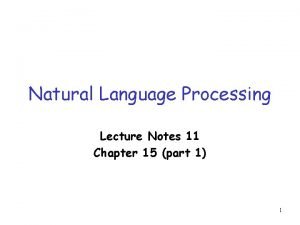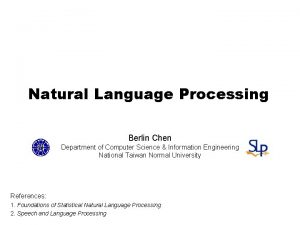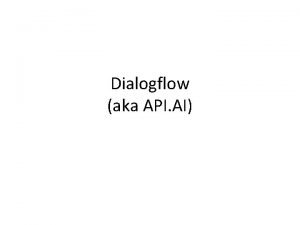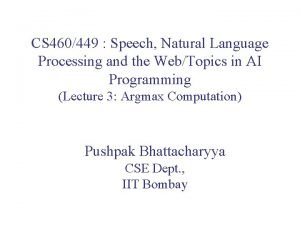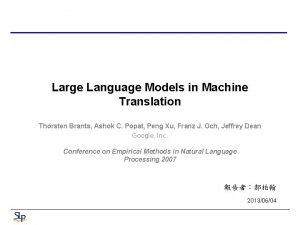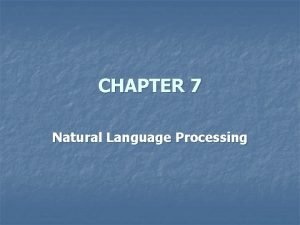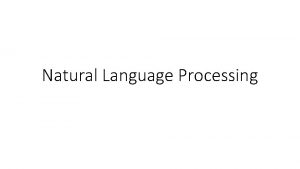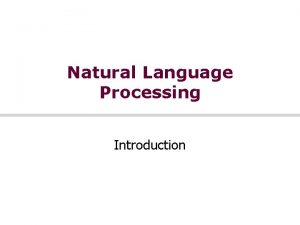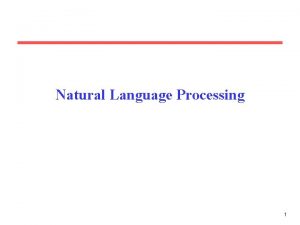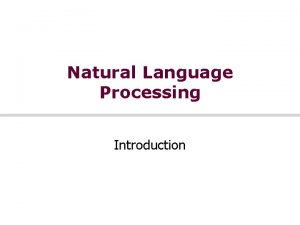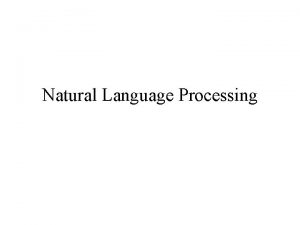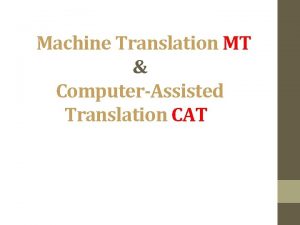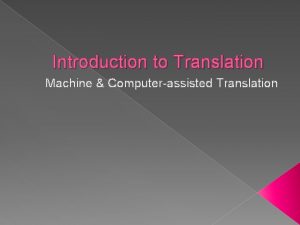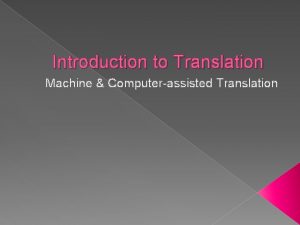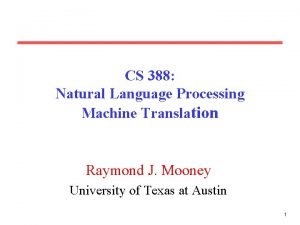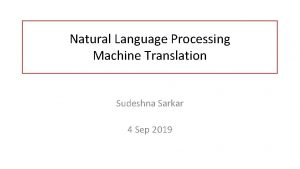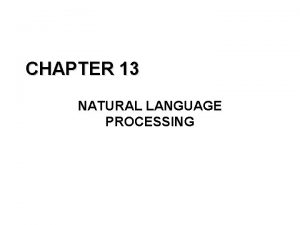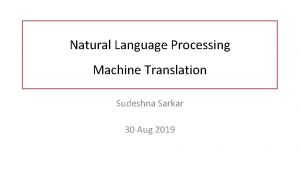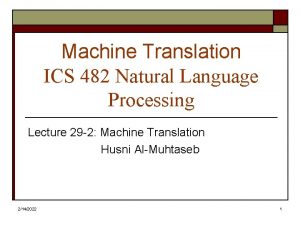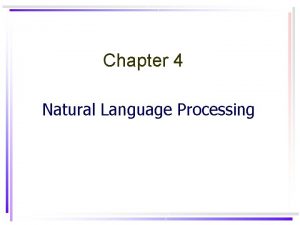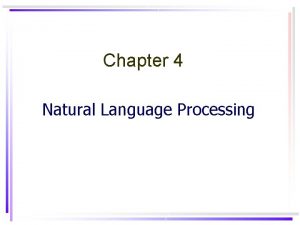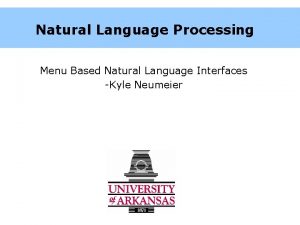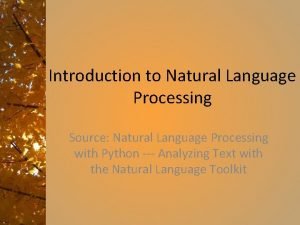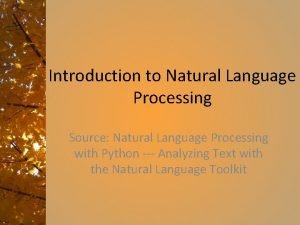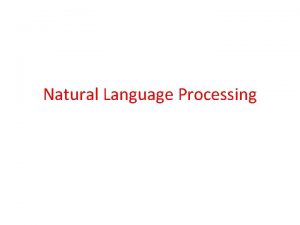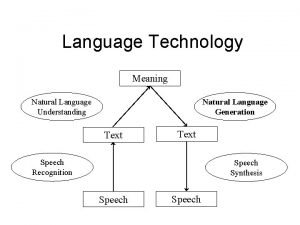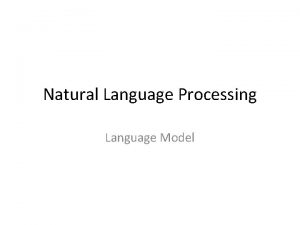Natural Language Processing Machine Translation MT Machine translation
































- Slides: 32

Natural Language Processing Machine Translation (MT)

• Machine translation was one of the first applications envisioned for computers • First demonstrated by IBM in 1954 with a basic word-for-word translation system 2

Rule-Based vs. Statistical MT • Rule-based MT: – – Hand-written transfer rules Rules can be based on lexical or structural transfer Pro: capturing complex translation phenomena Con: very labor-intensive -> lack of robustness • Statistical MT – – Mainly word or phrase-based translations Translation are learned from actual data Pro: translations are learned automatically Con: difficult to model complex translation phenomena 3


Rule-Based vs. Statistical MT • Statistical MT: Word-based Vs. Phrase-based 5

Word-Level Alignments • Given a parallel sentence pair we can align words that are translations of each other: 6

Sentence Alignment • If document De is translation of document Df how do we find the translation for each sentence? • The n-th sentence in De is not necessarily the translation of the n-th sentence in document Df • In addition to 1: 1 alignments, there also 1: 0, 0: 1, 1: n, and n: 1 alignments • Approximately 90% of the sentence alignments are 1: 1 7

Sentence Alignment (c’ntd) • There are several sentence alignment algorithms: – Align (Gale & Church): Aligns sentences based on their character length (shorter sentences tend to have shorter translations then longer sentences). Works astonishingly well – Char-align: (Church): Aligns based on shared character sequences. Works fine for similar languages or technical domains – K-Vec (Fung & Church): Induces a translation lexicon from the parallel texts based on the distribution of foreign. English word pairs. 8

Computing Translation Probabilities • Given a parallel corpus we can estimate P(e | f) • The maximum likelihood estimation of P(e | f) is: freq(e, f)/freq(f) • Way too specific to get any reasonable frequencies! Vast majority of unseen data will have zero counts! • P(e | f ) could be re-defined as: • Problem: The English words maximizing P(e | f ) might not result in a readable sentence 9

Computing Translation Probabilities (c’tnd) • We can account for adequacy: each foreign word translates into its most likely English word • We cannot guarantee that this will result in a fluent English sentence • Solution: transform P(e | f) with Bayes’ rule: P(e | f) = P(e) P(f | e) / P(f) • P(f | e) – adequacy (translation model) • P(e) – fluency (language model) 10

Decoding • The decoder combines the evidence from P(e) and P(f | e) to find the sequence e that is the best translation: 11

Noisy Channel Model for Translation 12

Translation Model • Determines the probability that the foreign word f is a translation of the English word e • How to compute P(f | e) from a parallel corpus? • Statistical approaches rely on the co-occurrence of e and f in the parallel data: If e and f tend to co-occur in parallel sentence pairs, they are likely to be translations of one another 13

Translation Steps 14

IBM Models 1– 5 • Model 1: Bag of words – Unique local maxima – Efficient EM algorithm (Model 1– 2) • Model 2: General alignment: • Model 3: fertility: n(k | e) – No full EM, count only neighbors (Model 3– 5) • Model 4: Relative distortion, word classes • Model 5: Extra variables to avoid deficiency 15

IBM Model 1 Recap • IBM Model 1 allows for an efficient computation of translation probabilities • No notion of fertility, i. e. , it’s possible that the same English word is the best translation for all foreign words • No positional information, i. e. , depending on the language pair, there might be a tendency that words occurring at the beginning of the English sentence are more likely to align to words at the beginning of the foreign sentence 16

IBM Model 3 • IBM Model 3 offers two additional features compared to IBM Model 1: – How likely is an English word e to align to k foreign words (fertility)? – Positional information (distortion), how likely is a word in position i to align to a word in position j? 17

IBM Model 3: Fertility • The best Model 1 alignment could be that a single English word aligns to all foreign words • This is clearly not desirable and we want to constrain the number of words an English word can align to • Fertility models a probability distribution that word e aligns to k words: n(k, e) • Consequence: translation probabilities cannot be computed independently of each other anymore • IBM Model 3 has to work with full alignments, note there are up to (l+1)m different alignments 18

IBM Model 1 + Model 3 • Iterating over all possible alignments is computationally infeasible • Solution: Compute the best alignment with Model 1 and change some of the alignments to generate a set of likely alignments (pegging) • Model 3 takes this restricted set of alignments as input 19

Pegging • Given an alignment a we can derive additional alignments from it by making small changes: – Changing a link (j, i) to (j, i’) – Swapping a pair of links (j, i) and (j’, i’) to (j, i’) and (j’, i) • The resulting set of alignments is called the neighborhood of a 20

IBM Model 3: Distortion • The distortion factor determines how likely it is that an English word in position i aligns to a foreign word in position j, given the lengths of both sentences: d(j | i, l, m) • Note, positions are absolute positions 21

Deficiency • Problem with IBM Model 3: It assigns probability mass to impossible strings – Well formed string: “This is possible” – Ill-formed but possible string: “This possible is” – Impossible string: • Impossible strings are due to distortion values that generate different words at the same position • Impossible strings can still be filtered out in later stages of the translation process 22

Limitations of IBM Models • Only 1 -to-N word mapping • Handling fertility-zero words (difficult for decoding) • Almost no syntactic information – Word classes – Relative distortion • Long-distance word movement • Fluency of the output depends entirely on the English language model 23

Phrase-based models • Word-based models translate words as atomic units • Phrase-based models translate phases as atomic units

Phrase Table • Main knowledge source: table with phrase translations and their probabilities • Example for natuerlich

Learning a Phrase Table • From a parallel corpus: – First run word alignment – Then, extract phrases – Finally assign phrase probabilities

Extract Phrases • Extract consistent phrases

Extract Phrases

Consistent Phrase

Assign Phrase Probabilities

Phrase-based Model

Log-linear model
 Machine translation in natural language processing
Machine translation in natural language processing Natural language processing vietnamese
Natural language processing vietnamese Probabilistic model natural language processing
Probabilistic model natural language processing Natural language processing nlp - theory lecture
Natural language processing nlp - theory lecture Markov chain nlp
Markov chain nlp Christopher manning stanford
Christopher manning stanford Grammar adalah
Grammar adalah Natural language processing
Natural language processing Natural language processing lecture notes
Natural language processing lecture notes Foundations of statistical natural language processing
Foundations of statistical natural language processing Natural language processing fields
Natural language processing fields Natural language processing fields
Natural language processing fields Natural language processing lecture notes
Natural language processing lecture notes Façade michael mateas
Façade michael mateas Collocation nlp
Collocation nlp Junghoo cho ucla
Junghoo cho ucla Prolog language
Prolog language Natural language processing wikipedia
Natural language processing wikipedia Pengertian natural language
Pengertian natural language Natural language processing
Natural language processing Natural language processing
Natural language processing Logical form
Logical form Natural language processing lecture notes
Natural language processing lecture notes Reference phenomena in nlp
Reference phenomena in nlp Kaiwei chang
Kaiwei chang Nyu natural language processing
Nyu natural language processing Natural language processing lecture notes
Natural language processing lecture notes Natural language processing lecture notes
Natural language processing lecture notes Natural language processing berlin
Natural language processing berlin Dialogflow natural language processing
Dialogflow natural language processing Natural language processing
Natural language processing Thorsten brants
Thorsten brants Top-down processing
Top-down processing
